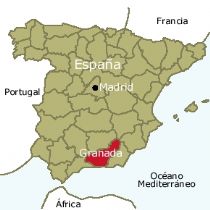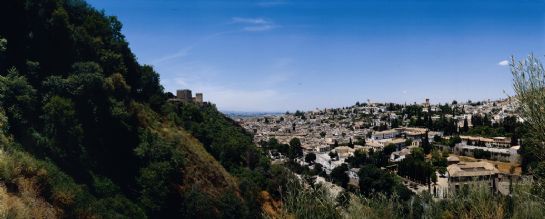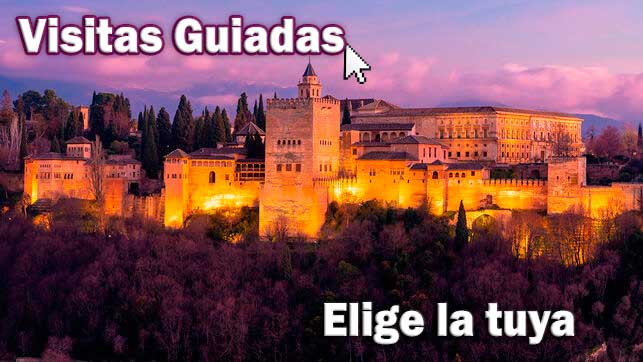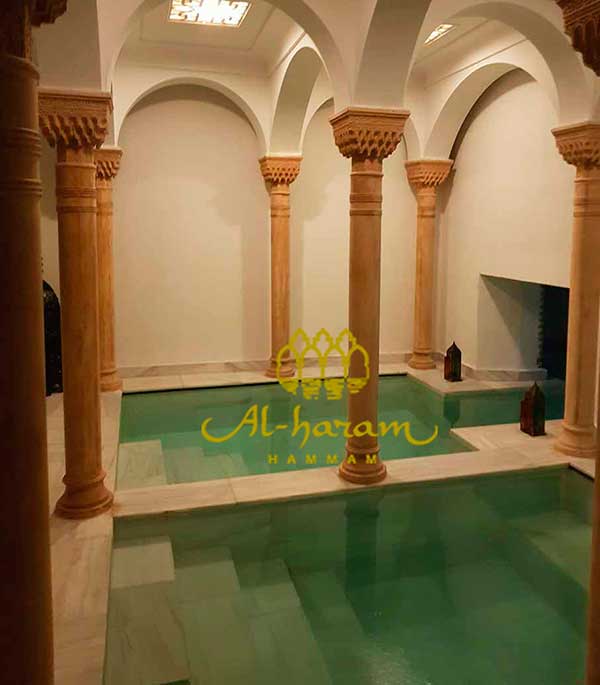- Home
- Granada Guide
- Information Granada
City
 Granada is the capital city of the province with the same name, located in south-eastern Spain between the shores of the Mediterranean Sea and the Andalusian hinterland. The city is located at the foot of Sierra Nevada, the highest mountain range of the Iberian peninsula. With more than a thousand years of recorded history, Granada enjoys one of Spain's most important cultural and architectural patrimonies. Besides the Alhambra, the world renowned palaces and fortresses of the Nasrid dynasty, and the historical Moorish quarter Albaicin, both designated as Patrimony of Humanity by the UNESCO, Granada boasts a Renaissance cathedral dating from the 16th century and many other architectural monuments of the first magnitude.
Granada is the capital city of the province with the same name, located in south-eastern Spain between the shores of the Mediterranean Sea and the Andalusian hinterland. The city is located at the foot of Sierra Nevada, the highest mountain range of the Iberian peninsula. With more than a thousand years of recorded history, Granada enjoys one of Spain's most important cultural and architectural patrimonies. Besides the Alhambra, the world renowned palaces and fortresses of the Nasrid dynasty, and the historical Moorish quarter Albaicin, both designated as Patrimony of Humanity by the UNESCO, Granada boasts a Renaissance cathedral dating from the 16th century and many other architectural monuments of the first magnitude.
GRANADA (Andalusia, Spain): - Surface: 12.638 Km² - Altitude: 738 m. - Coordinates: 37°11′ N 3°36′ W- Population: 240522 hab. - Gentile: Granadinos
Population
Granada has a permanent population of some 243,000 inhabitants, but the reality is considerably higher, as this figure is augmented by some 60,000 university students during the academic year and by a considerable tourist population in summer. The population breakdown by ages is the following: 22% fewer than 20 years old, 16% over 65 years, leaving an active population of 62%. The breakdown between men and women is 46/53%, approximately.
Spanish Office Hours are Different
Official office hours in Spain are from 8:30 or 9:00 to 14:00 or 14:30. That is the best time to contact any Spanish companies or institutions. In the afternoon, most public services are closed, except emergency services. Private companies are normally open from 17:00 to 20:30 or 21:00 in the afternoon. During the summer, many companies work a "jornada intensiva" (continuous working day) from 8:00 am till 3:00 p.m. and take the afternoon off.
Access to Granada
Granada has excellent accesses via train, plane and automobile. The airport is just 15 kilometers from Granada, close to the historic town of Santa Fe. Cars can be rented at the airport, and there is also a frequent bus service to the city. The train station is in the city center, making it particularly convenient. The A-92 dual carriageway takes motorists to Seville in two-and-a-half hours, to Malaga in an hour and a half, making Granada an excellent base for touring in Andalusia. The city's new four-lane "circunvalación" ring road greatly facilitates motor traffic in and around Granada, elegantly resolving access to both the Alhambra and the Sierra Nevada ski station. The new bus station on the city's northern edge provides bus service with the four corners of the Spanish geography.
The Environ in Granada
Granada is situated at the foot of Sierra Nevada, the highest mountain range of the Iberian Peninsula. Besides providing a dramatic backdrop for the city, Sierra Nevada is home to southernmost Europe's ski station, and the scene of important international ski championships in recent years. The ski area is less than an hour drive from the city, via one of Europe's finest ski access roads.
The Mediterranean beach is also within easy striking distance of Granada, less than an hour by car, with resort and residential towns like Motril, Almuñecar, Salobreña and many more. The traditional summering spot for local families, the Granada coast, with it's sub-tropical climate, and agriculture dedicated to exotic fruits, is increasingly attracting foreign visitors and residents.
A prime choice for rural tourism in the province of Granada is the Sierra Alpujarra, actually Sierra Nevada's southern slopes which drop all the way to the Mediterranean. Tucked into the canyons and valleys of the region, there are more than 50 villages. Its bucolic air, its forests of oaks and chestnut trees and its welcoming villagers, not to mention their renowned rose wines, mountain hams and local handicrafts, make this region a powerful attraction for visitors both from the rest of Spain and abroad.

Panoramic view of Granada from the Valley of the Valparaiso. Photo: EDILUX
The Granada Cultural Legacy
The city which today is Granada was founded by the Romans under the name of "Illibris." It was the Moors, who invaded it in the eighth century A.D. and stayed on for seven centuries, who deemed the city "Granada." Ferdinand and Isabella, Spain's revered "Catholic Monarchs," conquered the Kingdom of Granada in 1492, culminating the Reconquest of the Iberian Peninsula for Christiandom.
It was during the siege of the city that Isabella of Castille conceded to Christopher Columbus the resources necessary to launch his expedición to the West Indies. This long and colorful history has left numerous imprints on Granada in the form of palaces, churches and other noble buildings which proclaim the rich cultural heritage of the city. The monumental duo comprised by the Alhambra and the Generalife, fortress, medina and palace of the Nasrid monarchs, is world renowned both for its evocative architecture and for its privileged vantage point overlooking the city of Granada. Within the same complex lies the Renaissance Palace built there in the 16th century by the emperor Charles the Fifth, grandson of the conquering Catholic Monarchs.
Une toile de fond si belle qu'elle en est presque kitsch
Du côté opposé de la vallée du fleuve Darro s'étend la quartier de l'Albaicín, fascinante succession d'étroites rues aux murs blancs, dont la moitié dissimulent les maisons traditionnelles, avec d'élégants jardins que les Grenadins appellent "cármenes." L'Albaicín abrite le Mirador de San Nicolás, la fameuse place où les visiteurs bénéficient d'une des vues les plus renommées au monde, celle de l'Alhambra et du Generalife, avec la Sierra Nevada enneigée, offrant une toile de fond si belle qu'elle en est presque kitsch.
Proche de l'Albaicín, quelque peu en amont du fleuve Darro mais tojours avec une vue majestueuse de l'Alhambra : le Sacromonte, avec sa sainte abbaye et ses traditionnelles grottes-logis gitans (dont la plupart sont désormais occupés par des résidents étrangers avisés). C'est là que les "zambras", spectacles flamenco de Grenade, ont traditionnellement été mis en scène au milieu de décors élaborés dans des caves, et ici également que la mairie de Grenade a récemment installé le Centro Flamenco de Estudios Escénicos. Le nouveau centre d'études flamenco est dirigé par un danseur de flamenco, Mario Maya, qui y débuta sa carrière dans les zambras de Sacromonte à neuf ans.
A Backdrop So Beautiful It's Almost Unreal
On the opposite side of the valley of the River Darro lies the Albaicin quarter, a fascinating collection of narrow white-walled streets which half hide the traditional town houses with gracious gardens which the Granadinos call "cármenes." Here in the Albaicín is located the Mirador de San Nicolás (San Nicolas Balcony), the famous plaza where visitors are feted with one of the most renowned views in the world, that of the Alhambra and Generalife, with the snowy Sierra Nevada providing a backdrop so beautiful it's almost unreal.
Adjacent to the Albaicín, just a bit farther up the River Darro but still with a commanding view of the Alhambra, is Sacromonte, with its hallowed abbey and traditional Gypsy-cave residences (most of which are now occupied by astute foreign residents). It is here that Granada's "zambra" flamenco shows have traditionally been staged in elaborate cave settings, and it is here that the Granada town hall has recently installed the Centro Flamenco de Estudios Escénicos (Stage Flamenco Studies Centre). The new center is under the direction of flamenco dancer, Mario Maya, who initiated his distinguished career here in the zambras of Sacromonte at the age of nine.
Granada's Illustrious Resting Places
Granada also offers visitors a Renaissance cathedral considered the first of its kind in Spain. Adjacent to the cathedral is the Royal Chapel (Capilla Real), commissioned by Ferdinand and Isabella as their last resting place. (Their first resting place was a tiny chapel on the Alhambra hill which is today subsumed by a hotel, the Parador de Turismo de Granada.) The city is also blessed with a score of historic churches built by the Christians after the Reconquest in a unique style which incorporated Moorish architectural themes and came to be known as "mudéjar."
Another obligatory stop on anyone's discerning Granada itinerary is the Casa-Museo Federico García Lorca in the Huerta de San Vicente, located in the municipal park dedicated to Granada's best-known and best-loved poet. The intimate little museum occupies the house and gardens where Lorca spent his summers as a child.
Besides this opulent monumental legacy, Granada offers a wide gamut of contemporary cultural attractions, starting with the city's annual International Festival of Music and Dance, with concerts and recitals staged in the Alhambra, the Palace of Charles the Fifth and the gardens of the Generalife. Other annual festival events in Granada are devoted to jazz, theater, and the tango. Add to this the stable offerings of Granada's museums, art galleries, public exhibition halls, theaters and auditoria and you have one of Europe's most evocative and best endowed destinations for cultural tourism.
A Granada Chronology
First and Second Centuries A.D. - After having hosted the Phoenician, Carthaginian and Greek settlements (the Greeks called the place "Elybirge"), Granada is occupied by the Romans who call it "Illiberis." Fifth Century A.D. - Visigothic occupation, the city maintains its civil, military and religious importance.
711 - Tarik, deputy of the North African governor, Musa ben Nusayr, leaves Tangier at the head of an army of 9,000 men and lands in Gibraltar. The total occupation of the Iberian peninsula takes them just five years.
713 - Definitive occupation of Granada by the Moors, who call the city "Ilbira," ("Elvira" for the Christians).
929 - Abdelrahman III proclaims himself Prince of the Believers and declares independence from Bagdad; the Cordoba caliphate is born.
1010 - Several strives among groups of different cultures and ethnias lead to the destruction of the city, after which it comes to be known as "Garnata," from which "Granada" later derives.
1031 - With the fall of the Omeya dynasty, independent kingdoms -"reinos de taifa"- begin to arise in all of al-Andalus.
1212 - The united armies of the kingdoms of Castille, Aragon and Navarre defeat the Almohades in the battle of Navas de Tolosa.
1231 - Al-Ahmar ibn Nasr, founder of the Nasrid dynasty (Nazarís), is named governor of Arjona, the city of his birth, and shortly afterwards extends his power over the cities of Jaen and Guadix. He establishes his capital in Granada.
1237 - The construction of the Alhambra begins, under the direction of al-Ahmar.
1314 - Work begins on the construction of the Generalife.
1482 - The War of Granada begins. Prince Boabdil siezes the throne from his father.
1491 - Boabdil, the last Nasrid king, capitulates before Ferdinand and Isabella and negociates the surrender of Granada on November 25.
1492 - The Catholic Monarchs enter Granada triumphantly on January 2.
1492 - Cardenal Cisneros decrees obligatory baptism for all the Moorish (Moriscos).
1568 - Led by Aben Humeya, and due to the repression they endure, the Moors of the Albaicin rebel. Don Juan de Austria puts down the rebellion and the Moriscos are expelled from Granada.
1883 - The first concerts are staged in the Palacio de Carlos V during the Corpus Christi celebrations, concerts which are the foundations of Granada's International Festival of Music and Dance.
1922 - Federico García Lorca and other intellectuals promote Spain's first Flamenco Song Contest (Concurso de Cante Jondo).
1936 - The Spanish Civil War breaks out. Federico García Lorca is assassinated outside the city.
1939 - End of the Civil War. Francisco Franco is autoproclaimed "generalísimo," 36 years of dictatorship follow.
1975 - Franco dies, the so-called "Transition" (to democracy) period begins.
1977 - First democratic elections after Franco regime. The centrist UCD party wins and Adolfo Suarez is named president.
1978 - The new Spanish Constitution is adopted.
1980 - First edition of the Granada Jazz Festival.
1981 - Failed coup d'etat in the Congreso de los Diputados, the Spanish legislature.
1995 - Granada named starting point of the Rally París-Dakar, a position it will retain in the years 1996, 1998 and 1999.
1996 - Sierra Nevada organizes the final of the World Alpine Ski Championships.
Source: GRANADATUR. City council of Granada.
Do you have any doubt? Call us
+34 958 91 80 29 From Monday to Friday 9.00 - 14.00 and 17.00 - 20.00Other Recommended Services
Choose your service




